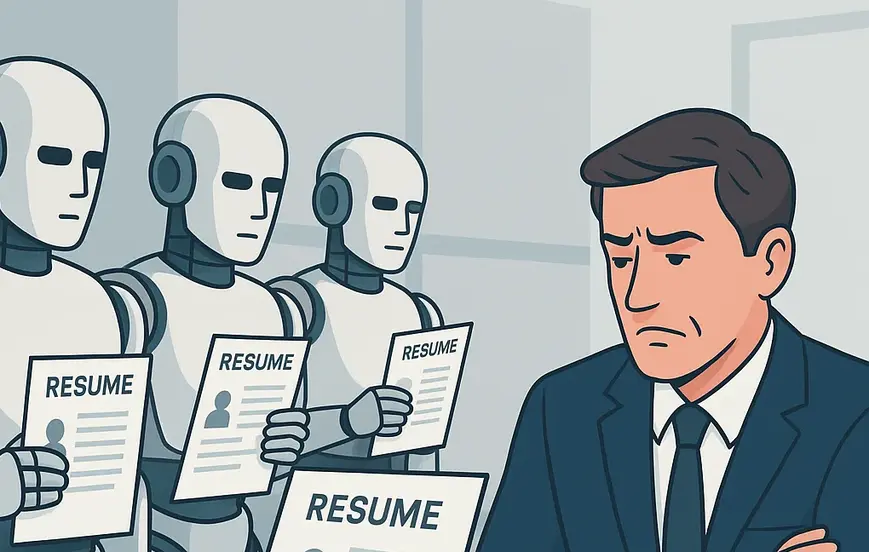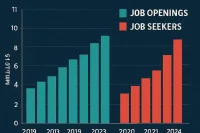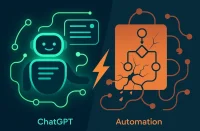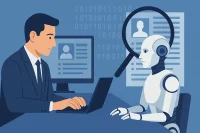Mounting layoffs in the tech industry have reached alarming levels as major companies including Google, Intel, Oracle, and Salesforce announce significant workforce reductions, with experts pointing to artificial intelligence as a primary driver of job displacement. The Bay Area, long considered the heart of technological innovation, is now experiencing the harsh reality of AI-driven automation that many industry experts warned about just six months ago.
The scale of these layoffs represents a fundamental shift in how technology companies operate, with AI implementation leading to the elimination of thousands of jobs across multiple sectors. Oracle’s announcement of 254 job cuts in Redwood City, Santa Clara, and Pleasanton, following their elimination of 289 jobs in August, demonstrates the ongoing nature of this workforce reduction trend.
Salesforce’s decision to lay off 262 workers from its San Francisco headquarters, just days after CEO Marc Benioff praised AI for allowing the company to cut 4,000 customer support jobs, illustrates how AI adoption is directly translating into job losses. These developments validate concerns that were previously dismissed as speculative or premature.
The AI-Driven Workforce Transformation: From Prediction to Reality
Rapid acceleration of AI implementation is fundamentally changing how companies operate and manage their human resources, creating unprecedented workforce challenges. Technology analyst Rob Early of the Ends Early Group warns that these layoffs represent a sign of troubled times, with companies diving headfirst into the artificial intelligence market while replacing employees with the very technology they helped create.
The pace of change has accelerated dramatically, with workforce transformations that previously took decades now occurring on a monthly basis. This rapid shift creates significant challenges for workers who must adapt to new technologies while facing the threat of replacement by the systems they helped develop.
The irony of this situation is particularly striking: employees who contributed to building AI systems are now being displaced by those same systems, creating a paradox where technological advancement comes at the cost of the people who made it possible.
Quality Concerns and Defect Management: The Hidden Costs of AI Implementation
These workforce reductions may be creating quality control problems that could have long-term consequences for companies and consumers. Early warns that by eliminating workers who might otherwise correct defects, companies are increasing the level of problems while reducing their capacity to address them.
The focus on AI implementation without adequate human oversight could lead to a cascade of quality issues that grow over time. As companies reduce their workforce in favor of automated systems, they may be sacrificing the human judgment and problem-solving capabilities that are essential for maintaining product and service quality.
This approach represents a short-term cost-cutting strategy that may prove counterproductive in the long run, as quality problems accumulate and customer satisfaction declines. The companies making these cuts may find themselves facing greater challenges than the immediate cost savings justify.
Oracle and Salesforce: Case Studies in AI-Driven Layoffs
Oracle’s recent announcement of 254 job cuts across multiple California locations exemplifies this trend, representing the company’s second major workforce reduction in recent months. This pattern of ongoing layoffs suggests that AI implementation is creating a sustained need for workforce reduction rather than a one-time adjustment.
Salesforce’s approach is particularly notable, as CEO Marc Benioff has been vocal about AI’s role in enabling job cuts. The company’s decision to eliminate 4,000 customer support jobs while praising AI capabilities demonstrates how technology adoption is directly translating into workforce reduction.
These layoffs represent more than just cost-cutting measures; they reflect a fundamental shift in how these companies view the role of human workers in an AI-driven business environment. The elimination of customer support positions suggests that AI is being trusted with customer interactions that previously required human judgment and empathy.
AI and the Workforce Shift
AI-driven layoffs at Oracle and Salesforce highlight how technology is reshaping the workforce, replacing traditional roles with automation. Employers can adapt by hiring talent skilled in AI management, customer experience design, and human-AI collaboration. Post your job on WhatJobs today and connect with professionals ready to thrive in the evolving AI-driven business landscape.
Post a Job Free for 30 Days →Intel’s Massive Workforce Reduction: 25% Cut by Year’s End
Intel’s plan to reduce its workforce by 25% before the end of the year represents the most dramatic expression of this workforce reduction trend. This massive reduction represents one of the largest workforce cuts in the company’s history and signals a fundamental restructuring of how the semiconductor giant operates.
Intel’s workforce reduction comes at a time when the company is facing increased competition and pressure to innovate in AI and other emerging technologies. The scale of these cuts suggests that the company is betting heavily on automation and AI to maintain its competitive position.
The timing of these layoffs, combined with the broader trend across the tech industry, suggests that Intel’s decision may be part of a larger pattern of companies preparing for a future where human workers play a smaller role in technology development and production.
The Dot-Com Collapse Comparison: Is This Worse?
Some experts suggest that the current situation may be worse than the dot-com collapse of the early 2000s, with different underlying causes and potentially more permanent consequences. Early’s prediction that the current crisis could be “clean worse than the dot com collapse” reflects the unprecedented scale and speed of workforce reduction.
The dot-com collapse was characterized by the failure of many companies and the elimination of jobs through business closures. The current situation is different in that it involves established, profitable companies eliminating jobs through AI implementation rather than business failure.
This distinction is important because it suggests that the current wave of layoffs may be more permanent and structural than the cyclical job losses that characterized previous tech industry downturns. The jobs being eliminated may not return even when economic conditions improve.
The Human Cost: More Than 10,000 Jobs Lost Nationwide
More than 10,000 jobs have been lost nationwide in 2025 alone, with more cuts predicted to follow, representing a significant human cost that extends beyond individual workers. This represents a significant human cost that extends beyond individual workers to their families and communities.
The concentration of these layoffs in the Bay Area has particular implications for the regional economy, as high-paying tech jobs are replaced by fewer, more specialized positions. The ripple effects of these job losses extend to local businesses, housing markets, and community services.
The psychological impact on remaining workers cannot be underestimated, as they face increased workloads, job insecurity, and the constant threat of replacement by AI systems. This creates a challenging work environment that may affect productivity and innovation.
The Future of Work: Adapting to an AI-Driven Economy
These developments raise fundamental questions about the future of work and how society will adapt to an economy increasingly dominated by artificial intelligence. The current trend suggests that traditional employment patterns may be permanently altered.
Workers in affected industries must consider how to adapt their skills and career paths to remain relevant in an AI-driven economy. This may require significant retraining and education to develop skills that complement rather than compete with AI systems.
The challenge for policymakers and business leaders is to manage this transition in a way that minimizes human suffering while maximizing the benefits of AI technology. This may require new approaches to education, training, and social safety nets.
Industry Response: Rebalancing and Restructuring
Companies are framing these workforce reductions as necessary rebalancing and restructuring to better serve customers and fuel growth areas. However, this framing may obscure the fundamental shift toward AI-driven operations that is driving these changes.
Salesforce’s statement about “continuously assessing our workforce and rebalancing as needed” suggests that these layoffs are part of an ongoing process rather than a one-time adjustment. This indicates that more workforce reductions may be coming as AI capabilities continue to improve.
The challenge for companies is to balance the benefits of AI implementation with the need to maintain human expertise and judgment in areas where it remains essential. This requires careful planning and consideration of the long-term implications of workforce reduction.
Restructuring for the AI Era
As industries rebalance and restructure around AI, companies must combine technology adoption with human expertise. Employers can stay competitive by hiring professionals who understand both digital transformation and the value of human judgment. Post your job on WhatJobs today and connect with candidates ready to drive growth while balancing innovation and people-first leadership.
Post a Job Free for 30 Days →The Path Forward: Managing the AI Transition
These workforce reductions represent a critical moment in the evolution of work and technology, requiring careful management of the transition to an AI-driven economy. The challenge is to manage this transition in a way that benefits both companies and workers while maintaining the innovation and growth that have characterized the tech industry.
This may require new approaches to education and training that prepare workers for an AI-driven economy. It may also require new forms of social support and safety nets to help displaced workers transition to new careers.
The companies making these cuts have a responsibility to consider the broader implications of their decisions and to work with policymakers and educators to ensure that the benefits of AI technology are shared broadly across society.
Frequently Asked Questions
What does mounting layoffs in the tech industry mean for workers?
Mounting layoffs in the tech industry means that thousands of workers are losing their jobs as companies implement AI systems, requiring workers to adapt their skills and consider new career paths in an increasingly automated economy.
How does mounting layoffs in the tech industry compare to previous downturns?
Mounting layoffs in the tech industry may be worse than previous downturns like the dot-com collapse because they involve profitable companies eliminating jobs through AI implementation rather than business failures, suggesting more permanent structural changes.
What are the main causes of mounting layoffs in the tech industry?
Main causes include AI implementation replacing human workers, companies focusing on automation and efficiency, quality control concerns, and the need to restructure operations to remain competitive in an AI-driven market.
How can workers prepare for mounting layoffs in the tech industry?
Workers can prepare by developing skills that complement AI systems, seeking retraining opportunities, considering career transitions to less automatable fields, and staying informed about industry trends and technological developments.
A Real-World Example: Maria’s Career Transition
Maria Rodriguez, a 32-year-old software engineer from San Francisco, exemplifies how mounting layoffs in the tech industry can force workers to adapt and find new opportunities. After being laid off from her position at a major tech company, Maria had to quickly reassess her career path and develop new skills.
“I was shocked when I got the layoff notice, but mounting layoffs in the tech industry had been in the news for months, so I knew I needed to prepare,” Maria explains. “I decided to use my severance package to retrain in AI ethics and human-AI collaboration, areas where human expertise is still essential.”
Maria’s transition from traditional software development to AI ethics consulting took six months of intensive study and networking. She discovered that while AI can replace many technical tasks, there’s still a strong demand for human expertise in areas like ethical AI development, human-AI interaction design, and AI policy.
“Mounting layoffs in the tech industry taught me that the key to surviving in an AI-driven economy is to focus on skills that complement rather than compete with AI systems,” Maria says. “I now work as a consultant helping companies implement AI responsibly while maintaining human oversight and ethical standards.”
Within a year of her layoff, Maria was earning more than her previous salary while working on projects that she found more meaningful and future-proof. Her experience demonstrates that while mounting layoffs in the tech industry present significant challenges, they also create opportunities for workers willing to adapt and develop new skills.




